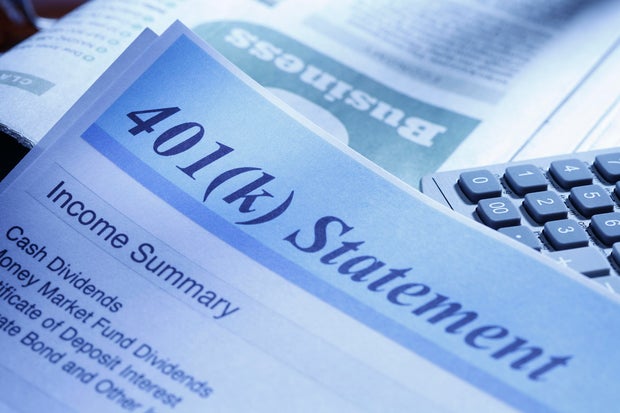What is a 401(k)? What to know about this retirement investment vehicle
What is a 401(k)?
There are many types of retirement accounts out there, but the 401(k) may just be the most convenient.
In a traditional, employer-sponsored 401(k) - named after a subsection of the U.S. tax code - employees choose to have a pre-tax percentage of their income withdrawn and put into the account. Most employers offer a selection of stocks, bonds, cash, mutual funds and other investments. The money is typically taxed upon withdrawal later in life.
If you want to make sure you're on track for a smooth retirement, consider checking out different retirement options. There are several online tools available to help you open a new retirement account that can offer more flexibility.
Once you organize all of your finances, then it's time to evaluate your retirement plans. A 401(k) is likely among them. Here's a quick guide to help you better understand 401(k)s and how to manage them.
Table of contents
- How much can you contribute to your 401(k)?
- How much should you contribute?
- How is a 401(k) plan taxed?
- Can you withdraw from your 401(k) account without a penalty?
- Can you take out a loan against your 401(k) plan?
- What happens to my 401(k) if I change jobs?
- 401(k) alternatives
How much can you contribute to your 401(k)?
The Internal Revenue Service sets the contribution limit for 401(k)s annually. This limit varies based on your age, but for 2022, most Americans can contribute up to $20,500 across the entire year. If you're 50 or older, the limit goes up to $27,000 (this allows workers nearing retirement a catch-up contribution).
That is just your personal contribution limit, though. You can technically exceed these amounts - up to 100% of your compensation or $61,000 in 2022, whichever is lower - if your employer also contributes to the account. Some employers offer a matching contribution, meaning for each dollar you contribute to your account, they'll contribute a matching amount up to a certain threshold.
How does your 401(k) compare? Are you saving enough? If you're looking to boost your savings, sign up for this financial tool that includes expert insights on how you could improve your plan and possibly save even more money.
If you aren't already, make sure you're taking full advantage of employer matching. According to a report from investment management group Vanguard, most employers with matching benefits will contribute 50 cents on the dollar for up to 6% of the employee's pay. So if you made $50,000, your employer would contribute up to $1,500 per year, provided you contributed at least $3,000 yourself (50,000 x .06).
How much should you contribute?
Ideally, you'd take advantage of the IRS maximum contribution limit to your account year after year. But if that's not possible financially, start by contributing enough to max out your employer contribution. If you're not sure what that is, check with your company's benefits administrator. They can walk you through the matching contribution policy and direct you on how to set up contributions.
"Contribute the maximum your household budget will allow, up to the maximum annual contributions allowed by the IRS," says Daniel Milan, managing partner at Cornerstone Financial Services. "At the very least, if your company offers a match, you should contribute at least the percentage required to get the maximum match, as that is free money you're leaving on the table if you don't."
Pay attention, though. Your company may change its matching policy from time to time, so make sure to check in annually with your plan administrator. You'll want to take full advantage of any employer contributions as long as it's financially possible.
How is a 401(k) plan taxed?
There are two main kinds of 401(k) plans: traditional and Roth.
Traditional: You don't pay federal income tax on a traditional 401(k) plan contributions until you withdraw from the account. That means investments grow tax-free.
Roth: Contributions to a Roth 401(k) are made after taxes. When you withdraw, the funds won't be taxed because you contributed with post-tax income.
An Individual Retirement Account (IRA) is opened by an individual, usually through an investment firm, bank, insurance company or broker. A 401(k) is opened and managed by an employer. Under IRS rules, contribution limits are higher for a 401(k) than for an IRA.
The limit for employer-sponsored 401(k) plans in 2022 is $20,500 after the IRS raised the limit by $1,000 last year. That's far higher than the $6,000 maximum for traditional and Roth IRAs.
Can you withdraw from your 401(k) account without a penalty?
In general, taking money out of a retirement plan before reaching age 59 ½ comes with a penalty. The IRS calls this move an early - or "premature" - distribution. You'll wind up paying a 10% tax on the early withdrawal unless you qualify for an exception.
Can you take out a loan against your 401(k) plan?
If your plan allows it, you can borrow up to $50,000 or half your vested balance. Most plans give borrowers up to five years to pay the loan back - with interest.
Be careful, though: if you lose your job and don't repay by that year's tax deadline, the IRS considers your loan a withdrawal. That means if you're younger than 59 ½, you might have to pay the 10% early withdrawal tax penalty.
What happens to my 401(k) if I change jobs?
Most payments to your 401(k) plan can be "rolled over" to another 401(k) plan or an IRA within 60 days. You can ask your financial institution or plan administrators to directly transfer the payment. You generally won't pay taxes on the funds until you withdraw from the new plan.
401(k) alternatives
If you're able to max out your (and your employer's) 401(k) contributions and still have disposable funds leftover, you might want to consider contributing to other accounts in addition to your 401(k).
Some options include:
- IRAs: Both traditional and Roth IRAs can be smart options. These allow you to contribute up to $6,000 annually (more if you're 50 or older) and build wealth for retirement. The difference between the two lies in their tax treatment. With traditional IRAs, you pay taxes upon withdrawal, while Roth IRA contributions are post-tax, meaning you pay taxes on the income first and then make the contribution. This allows you to avoid taxes when you withdraw funds later on.
- Health Savings Accounts: With an HSA, you can set aside pre-tax money to use toward health care costs, including things like medications, first aid supplies, health insurance deductibles, and other health-related expenses you might incur (like COVID-19 tests, for example).
- Life insurance: If you have a spouse or dependents, putting extra funds toward a life insurance policy could be financially wise. Make sure to talk to an insurance agent if you opt for this strategy, as there are several types of policies to think about.
- 529 plans: A 529 plan lets you build up funds for your child's future college costs. Some plans even let your child use the money for trade school and other expenses once they reach a certain age. (This varies by state, though, so check with a financial professional in your area).
You can also talk to a financial advisor, who can help you determine the best strategy for your budget and retirement goals. They can provide investment, saving and budgeting guidance personalized to your specific situation.








